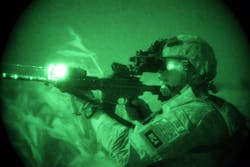Northrop Grumman picks SemiConductor Devices (SCD) to provide infrared sensors for day and night targeting
APOPKA, Fla. – Electro-optical sensors experts at the Northrop Grumman Corp. Mission Systems segment in Apopka, Fla. needed infrared sensors for the Next Generation Handheld Targeting System (NGHTS) that Northrop Grumman is building for the U.S. Marine Corps. They found their solution from SemiConductor Devices (SCD) in Colorado Springs, Colo.
Northrop Grumman has chosen SCD to provide the high performance and small size, weight and power consumption (SWAP) infrared (IR) solution to support the Marine Corps NGHTS system.
NGHTS is a lightweight portable system that enables Marines to acquire targets quickly in day and night conditions; perform guidance against targets; and generate target location data during combat operations. NGHTS will combine target location, laser spot imaging, and laser target designation.
The SCD infrared imaging solution is part of company's Sparrow product family, which is based on SCD's 640-by-512-pixel 10-micron infrared focal plane array with mature XBn high-operating-temperature (HOT) technology.
Related: EO/IR sensors boost situational awareness
The Sparrow enables new capabilities for a wide range of applications that otherwise would have to rely on larger, heavier, and more expensive sensors that consume a lot of power, SCD officials say.
Sparrow is appropriate for hand-held sensors, tactical mini-unmanned aerial vehicle (UAV) sensor payloads, armored vehicle sights, sniper thermal weapon sights, and perimeter security sensors.
The Sparrow has a digital readout integrated circuit (ROIC), a linear cooler with high-reliability and performance, integrated smart electronics to support the cooler, focal plane array control, and built-in image processing.
The Marine Corps Systems Command at Quantico Marine Base, Va., announced a $252 million eight-year contract to Northrop Grumman in February to design and build NGHTS.
The NGHTS handheld targeting system will combine all of the legacy capabilities into one system that is compatible with current and future fire-support systems, and will support the Marine Corps for the next 15 to 20 years. NGHTS will reduce the weight of Marine Corps laser designation and laser spot imaging capability by 60 percent, experts say.
The Marines today use four legacy systems: the Portable Lightweight Designator Rangefinder, Joint Terminal Attack Controller, Laser Target Designator and Thermal Laser Spot Imager. The intent is for NGHTS to replace all four systems.
"Our engineering and production teams ensured the rapid and seamless integration of our SWAP cooled IR solution into the Northrop Grumman solution," says Mark Fydenkevez, CEO of SCD.
For more information contact SCD online at https://scdusa-ir.comor Northrop Grumman Mission Systems at www.northropgrumman.com/who-we-are/business-sectors/mission-systems.
